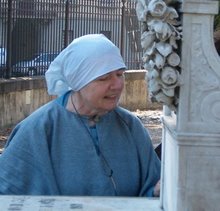HAITI AND ROMANIA: SLAVERY AND FREEDOM
Haiti and Romania seem far apart yet are not. One is black, the other white. But in Romania, as in Haiti, much of the population were enslaved, in Romania these being the Roma, the 'gypsies' who had come from India a thousand years ago with their ancestral skills. The duration of enslavement of the Roma to nobles and monasteries was from the Middle Ages until the nineteenth century when Uncle Tom's Cabin was translated into Romanian. In both countries the slaves, even when freed, were denied decent housing, work with dignity, education. The two far-apart countries run a very close parallel to each other.
These are suggestions for Wyclef Jean, learned from the Roma of Romania begging in the streets of Florence.
I. The most important unit is the family.
II. Be sure that each family can have land to build on and on which to grow food.
III. Immediately import tents, wood house kits, and other earthquake-proof building materials not available within the country for Haitian families. Create work building these as well as Buckminster Fuller domes for schools and hospitals.
.
IV. Make sure that each family can conserve water with drainpipes and cisterns.
V. China now fabricates inexpensive solar kits that can run a light and recharge telephones and even a small laptop. Give each family independence from centralized power.
VI. Pay the older more infirm members of families who do know how to read and write to teach all those who do not.
VII. Have the families create their textbooks, publishing these on the Web with their drawings that can be downloaded for use. Have these textbooks share information on how to build houses, how to conserve water, how to grow food, how to prevent illness. Have teaching be in their dialect paired with globally dominant languages using colour-coded bilingual/multilingual texts. See http://www.ringofgold.eu/Romany.html, http://www.ringofgold.eu/roofs.html, http://www.ringofgold.eu/panourisolare.html, http://www.ringofgold.eu/doctorvisit.html
VIII. In the midst of the earthquake, despite their poverty, Haitians were beautifully dressed. Encourage local dressmakers to produce clothing in cottage industries so they can care, at the same time, for the children, rather than working in factories, 50% being for fellow Haitians, 50% for export.
I & II are true for Haiti and the Roma.
III, IV, V, VI, VIII are needful for Haiti and for the Roma.
Always combine work and study. Education, especially of women, is the cheapest and best investment a nation can make towards its development and well-being. At the same time the education in the home of building, farming, sewing and other skills needs equal respect and is of equal value to the formal education acquired in schools.
Our project for the Roma in Romania, submitted to the 'Decade of Roma Inclusion' of the Open Society Institute in Budapest, is called 'Home Building, Home Schooling,' and is suggested as the foundation for obtaining work in the European Union of which the Romanian Roma are citizens. It uses the concepts of Pestalozzi, Montessori, Fanon, Freire and Milani. Switzerland was a poor country which became rich through educating its citizens.

No comments:
Post a Comment